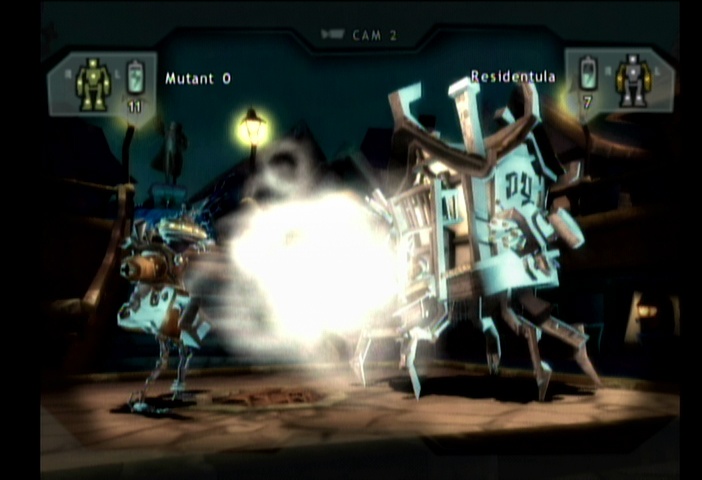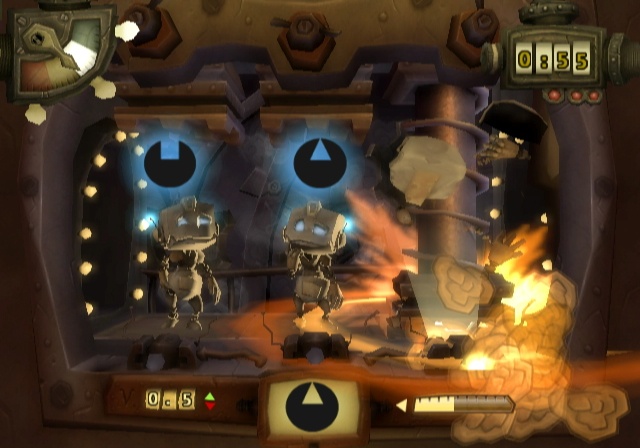If you were to judge Monster Lab by its cover, you might be put off by the green monster head licking a massive snot bubble off of the gruesome face beside it. What you would be missing, however, is a well-put-together game for a younger audience that includes a variety of minigames, an extensive monster-customization system, and easy-to-learn battle mechanics. Monster Lab starts off as an intriguing monster-experimenting game in which you build your own walking freak show to duke it out against other abominations. The game starts to fall apart as you progress, though, when the Wii motion controls mar what could have been an enjoyable experience.

As the newest apprentice in the Mad Science Alliance, your goal is to master the three sciences--mechanical, biological, and alchemical--in order to create the perfect monster to do your bidding. One of the former members, Baron Mharti, has gone off the deep end and is wreaking havoc with his miscreants in the Uncanny Valley, and it's up to you to stop him. The narrative doesn't extend beyond that, but the over-the-top voice acting and well-animated cutscenes keep the story entertaining. The professors that you'll meet are a diverse and deranged bunch and the Baron is your stereotypical monocled villain, with a well-manicured mustache and a maniacal laugh. You'll also meet other amusing characters along the way as you help them with fetch quests and monster-slaying duties.
Monster Lab is about experimenting. You are responsible for collecting junkyard ingredients to create arms, heads, torsos, and legs. Once you slap the pieces together and bring your hunk of junk to life, it will be yours to control. You deploy your Frankenstein creation from the comfort of the mad science castle and supervise through a camera. Exploring the regions of the Uncanny Valley is similar to a board game in which you are restricted to preset paths. The areas aren't very large, but they're all uniquely themed and have their own charm. You'll track down items through minigames and fight monsters that get in your way, consulting your quest log for tips on what to do next. Gameplay does start to feel monotonous after a while, but it's the headache-inducing load times before and after each battle that slow the gameplay significantly. This is incredibly frustrating when you consider that battles can often be shorter than the loading times.
When you collide head-on with a monster, you'll enter an arena and face off gladiator-style in a turn-based match. The fighting mechanics are simple: Two commands are tied to each body part, and you select and point to the one you wish to use. Actions require energy, and you can take a turn to recharge when you're low. To win, you need to take out the opponent's torso, or if you want to be cruel, destroy every limb and knock off the head. Part of the strategy is anticipating what your opponent is going to do next, but most of the fights are ridiculously easy as long as your monster hasn't gone too long without an upgrade. After each fight, the only way to heal is to do field repairs, which involves completing a short minigame. It isn't terrible, but it does start to feel like an interactive load screen that you need to slog through so that you can get on with the game.
In the first half of Monster Lab, the Wii motion controls work surprisingly well in the various minigames you encounter. Towards the second half, however, things take a turn for the worse. There's one alchemical minigame that has you flying through a tunnel with rotating openings that open and close. You're in first-person view with no indicator onscreen to let you know your exact dimensions and you're controlling yourself with the Wii Remote. If you manage to pass through a hole, it's out of sheer luck, and with that luck you'll get a boost in speed, which will promptly propel you into the next wall. Your skills will improve with practice, but it's no longer fun by that point. There are four levels of difficulty with all of the experimental minigames, and though most are manageable, there are a handful of games that are maddening because of the remote. The games that use the control stick are fine, as well as the one in which you're steering with the remote on its side. The problems tend to surround anything that involves pointing or shaking with the Wii Remote or Nunchuk. Your performance affects the resulting monster part, so you'll want to do well if you want to have a decent part to use.
The production values are quite high in Monster Lab. The graphics are pleasing, and the cinematics that are sprinkled throughout the game are well done. Even the battles are fun to watch because you know you'll always end the fight with a bone-crunching finish. On the auditory front, there isn't much in terms of music that stood out. However, there are appropriate sounds of nature and ambient noises to enhance the atmosphere in town or in the cemetery, from barking dogs to eerie groans.

One of the game's strengths is the customization, given that there are millions of possibilities with all of the ingredients and parts that you can collect and experiment with. After you've completed the game, you can continue to scavenge, build, and enhance your creation to pit it against friends online. Playing against a human changes the battle entirely, and it's interesting to see the creations that other players have come up with. It's similar to fighting a boss, except that they're generally smarter. The entire campaign will last more than 12 hours, depending on how much time you spend tinkering away in the lab.
Monster Lab's main appeal is in the collecting, building, and experimenting. It's rewarding to watch your creation come to life and see how it fares against a real opponent. Unfortunately, you can go only so far before the creeping repetition and unnatural minigames start to drive you mad.